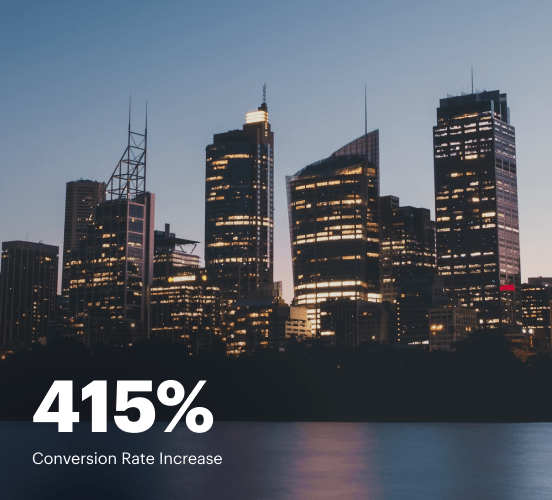How Pixpa vs. Drupal vs. Instapage stack up against each other
Compare Instapage with Pixpa and Drupal to create high-converting landing pages. With personalization, optimization, and collaboration tools, Instapage helps you deliver experiences that drive results.
Get startedSee how Instapage stacks up against the competition
| Feature | Instapage | Other builders |
| Drag-and-Drop Tools | ||
| Conversion-optimized templates | ||
| Manual and AI-powered A/B Tests | ||
| AI content suggestions | ||
| Popups and sticky bars | ||
| Canvas and grid blocks | ||
| Reusable and global elements | ||
| Form and popup builders | ||
| Built-in Heatmaps | ||
| Central analytics dashboard | ||
| Ad-to-page personalization and collections | ||
| Contacts, lists, and email | ||
| Dedicated, full-service CRO experts | ||
| Enterprise-ready platform |
Leading the way in building high-performing landing pages





Why Instapage is the smarter choice for your campaigns
Get everything you need to build, scale, and optimize high-converting landing pages—without coding.

Easier page building without coding
Instapage offers a flexible and seamless page creation experience with a library of 500+ conversion-focused layouts, Instablocks®, a drag-and-drop builder, and AI content generation. With technologies like Thor Render Engine®, you can create on-brand, mobile-responsive landing pages that load quickly and start converting during initial visitor clicks.

More insights — better results
Instapage lets you see in detail how each landing page experience and variation is performing so you can make targeted changes that boost page conversions. Use heatmaps for a better understanding of on-page activities, run A/B tests and AI-assisted experiments, and then track and evaluate results within robust analytics dashboards.

More personalized experiences
Instapage lets you quickly create high-performing landing pages tailored to each of your ad campaigns. Deliver personalized experiences for distinct audiences using dynamic text replacement. Effortlessly align specific advertisements to unique pages with AdMaps. Monitor audience-level metrics using our advanced data tools.

Built-in collaboration
Instapage collaboration capabilities bring your entire team together to speed up the process of landing page review, approval, and launch. No more frustrating and unnecessary revisions or edits scattered across emails. Provide instant feedback, conduct real-time page edits, and securely share your pages with outside stakeholders.

Free up time for your business
Invest time into business growth, not busy work. Launch landing pages faster with reusable forms and templates. Build once, reuse forever.
Explore all integrations






Easier page building without coding
Instapage offers a flexible and seamless page creation experience with a library of 500+ conversion-focused layouts, Instablocks®, a drag-and-drop builder, and AI content generation. With technologies like Thor Render Engine®, you can create on-brand, mobile-responsive landing pages that load quickly and start converting during initial visitor clicks.
More insights — better results
Instapage lets you see in detail how each landing page experience and variation is performing so you can make targeted changes that boost page conversions. Use heatmaps for a better understanding of on-page activities, run A/B tests and AI-assisted experiments, and then track and evaluate results within robust analytics dashboards.
More personalized experiences
Instapage lets you quickly create high-performing landing pages tailored to each of your ad campaigns. Deliver personalized experiences for distinct audiences using dynamic text replacement. Effortlessly align specific advertisements to unique pages with AdMaps. Monitor audience-level metrics using our advanced data tools.
Built-in collaboration
Instapage collaboration capabilities bring your entire team together to speed up the process of landing page review, approval, and launch. No more frustrating and unnecessary revisions or edits scattered across emails. Provide instant feedback, conduct real-time page edits, and securely share your pages with outside stakeholders.
Free up time for your business
Invest time into business growth, not busy work. Launch landing pages faster with reusable forms and templates. Build once, reuse forever.
Explore all integrationsGet started with Instapage in a few steps
-
Create your Instapage account
Start with Instapage by signing up via Google or your email. You'll get access to a free 14-day trial to discover Instapage capabilities. Feel free to cancel anytime during the 14-day trial if you decide that our product is not suitable for your business. -
Build and personalize your page
Create your first landing page from scratch or choose a template from 500+ customizable layouts. Use the drag-and-drop builder to add page elements, fonts, and backgrounds, refine content with AI, or add custom HTML, Javascript, and CSS. -
Review and make edits
Collaborate on page designs and streamline review processes. Invite your team members and stakeholders to review, edit, and provide feedback on your landing page. Collaborate knowing your page is confidential and only accessible to authorized users. -
Publish and track page performance
Publish your page to a domain or custom URL. Connect your pages to the ads you've created and track page performance within the analytics dashboard, run A/B tests and AI experiments, analyze results, and continuously optimize your landing page to maintain high conversions.
Instapage vs. Pixpa vs. Drupal – The Showdown of Landing Page Builders
Imagine you’re at a carnival, where each booth is a new landing page builder, and your goal is to find the ride that will take your marketing strategy to exhilarating heights. In this vibrant atmosphere, we have three standout contenders: Instapage, Pixpa, and Drupal. Each offers a unique experience, designed to turn visitors into customers. This article sets the stage for a friendly competition that will guide you through their strengths and weaknesses. Buckle up as we explore how these platforms can empower marketers to reduce costs, grow conversions, and deliver tailored landing page experiences that increase brand trust, cultivate customer loyalty, and boost overall conversion rates. With each round, we'll uncover how these tools differentiate themselves in the bustling marketplace of landing page builders, ensuring you have the insights needed to choose the right one for your needs.
Meet the Contenders: A Closer Look
In the left corner, we have Instapage, the beloved tool for marketers seeking to maximize conversions and create tailored landing page experiences. Known for its extensive features and user-friendly approach, Instapage is regarded as a must-have in any marketer's toolkit. In the right corner stands Pixpa, a platform that fuses simplicity with creativity, allowing users to design stunning websites and landing pages, making it a favorite for photographers and small businesses. Lastly, in the center ring, we have Drupal, a powerhouse of flexibility and scalability, known for its robust content management capabilities, often favored by larger enterprises and developers. Each platform has carved a niche in the digital landscape, giving marketers numerous templates, features, and customization options to consider. As we dive deeper into this showdown, we’ll see how they stack up against each other in various domains.
Round One – Features Face-Off
Template Diversity and User Friendliness
When it comes to choosing a landing page builder, the first thing that often stands out is the variety and ease of use of templates. Instapage offers an impressive array of high-converting templates designed specifically for different industries and objectives. These templates are easy to customize, allowing marketers to create unique landing pages without needing extensive design skills. Pixpa, meanwhile, brings a more visually artistic flair, offering beautifully designed templates that are great for portfolios and small businesses. However, while ease of use can vary, Pixpa’s template customization can sometimes pose challenges for those unfamiliar with web design conventions. On the other hand, Drupal provides an almost infinite array of templates powered by user-generated content, but this can be daunting for beginners since the platform heavily leans on customization capabilities, which often require technical expertise. It’s safe to say that while Instapage shines in user-friendliness, Pixpa captivates with its aesthetic charm, and Drupal stands as the powerful but complex maestro of options available.
Instapage: Your Partner in Customization and Conversion Rates
Instapage is not just another landing page tool; it’s a dedicated partner in emphasizing customization and conversion optimization. With its advanced features, such as A/B testing, dynamic text replacement, and detailed analytical insights, Instapage empowers marketers to create tailored experiences that will resonate with potential customers. It allows for rigorous testing to see what resonates best with audiences, making the process not only insightful but extremely beneficial for minimizing costs and maximizing conversions. Users appreciate the drag-and-drop interface that makes designing straightforward and their wide choice of integrations with numerous marketing tools. By fostering a user-friendly environment paired with powerful analytics, Instapage equips marketers with the necessary tools to enhance brand trust and customer loyalty, solidifying its reputation as a trusted choice for driving higher conversion rates.
Round Two – Speed and Performance Battle
Let’s dive into the next round, where we explore the essence of speed and performance. Picture this: you’re at your favorite coffee shop, and you’ve been waiting in line far too long. Just like that annoying wait can ruin your day, slow-loading landing pages can detract from user experience. Speed is crucial; it can make or break conversions. If a landing page takes too long to load, potential customers might abandon it before even seeing what it has to offer. So, how do these three contenders hold up under pressure?
Instapage Benefits:
- Optimized loading times that enhance user experiences.
- Advanced caching mechanisms to speed up page delivery.
- Asynchronous loading for images and scripts to boost overall performance.
- Integration with fast CDNs ensuring swift access globally
Pixpa Benefits:
- Good loading speeds due to optimized templates.
- Integrated image management for quicker loading of visual content.
- Responsive design ensures optimal performance across devices
Drupal Benefits:
- Highly customizable caching settings for improved performance.
- Ability to handle high traffic loads effectively.
- Robust framework that allows for optimization at various levels.
- Possibility to use CDN for faster content delivery
In summary, speed can vary across these platforms depending on user needs and configurations. Instapage emerges as a strong contender with its dedicated focus on ensuring fast loading times, while Pixpa provides decent speeds for more design-oriented users. Drupal, while powerful, demands a bit of technical understanding for optimal performance. For those looking for the best speed, Instapage takes the crown hands down.
Round Three – Easy Does It: Usability and Learning Curve
As we venture into usability, we can think of this round as a friendly welcome mat into each platform. The user interface plays a significant role in how smoothly newcomers can start their journey. Instapage's interface is designed with simplicity and intuitiveness in mind. It offers various tutorials and resources to help users without prior technical experience get their bearings quickly. This supportive environment makes it accessible for marketers at any stage. Pixpa, while visually stunning, has a slightly steeper learning curve due to its rich customization options. It’s fantastic for those with an eye for design, but less intuitive for users who prefer straightforward functionality. Drupal, true to its nature, is the most complex of the three and is often hailed as a steep mountain to climb for new users. However, once users are acclimated, the rewards of flexibility and scalability are abundant. All in all, while Instapage is user-friendly for all, Pixpa appeals to creatives, and Drupal targets users willing to invest time in learning.
Round Four – Support Mechanisms: The Unsung Heroes
Customer support is like having a reliable sidekick in your superhero journey. For marketers on the go, support plays a monumental role. Instapage excels in offering comprehensive customer support through various channels including live chat, email, and an extensive knowledge base. Their customer service team is often praised for being responsive and helpful. Meanwhile, Pixpa offers solid support as well, typically through chat and email, with a rich documentation resource to assist users. It’s reliable, but some users note slower response times than they would like. Drupal has a vast community forum and documentation, which can be quite valuable, but its official support can differ as it depends largely on the hosting provider, leaving some users yearning for more consistent help. In this round, it’s clear that Instapage solidifies its position as the champion for support mechanisms by offering a robust and readily available service.
Round Five – The Price is Right: Pricing Structures
As we approach the final round, let’s discuss pricing structures – the bottom line that often influences decisions. Instapage’s pricing plans cater to a range of needs and budgets, offering a flexible structure that can fit various marketing strategies. Although it’s on the higher end compared to Pixpa and Drupal, the value gained in conversion rates can justify the investment. The monthly fees include extensive features essential for successful landing pages. Pixpa, on the other hand, offers more budget-friendly plans suitable for small businesses and individuals, making it more accessible, especially for those wanting to develop portfolio sites without breaking the bank. Drupal, while open-source and free to use, often requires additional costs for hosting and premium modules, meaning expenses can vary greatly depending on individual needs. Each platform has its pros and cons, and understanding pricing structures helps users find what aligns best with their marketing goals.
In conclusion, while all three platforms possess unique strengths, the ultimate choice will depend on individual requirements and goals. Instapage shines with its user-friendly interface, robust support, and proven conversion optimization features. Pixpa appeals to creatives with its design-centric features, and Drupal remains a formidable option for developers and enterprise users. As you contemplate your needs, consider what matters most in a landing page builder—whether it be features, support, or pricing flexibility. Why not take Instapage for a spin with their free trial or demo? It just might be the superhero you need to propel your marketing efforts forward.










